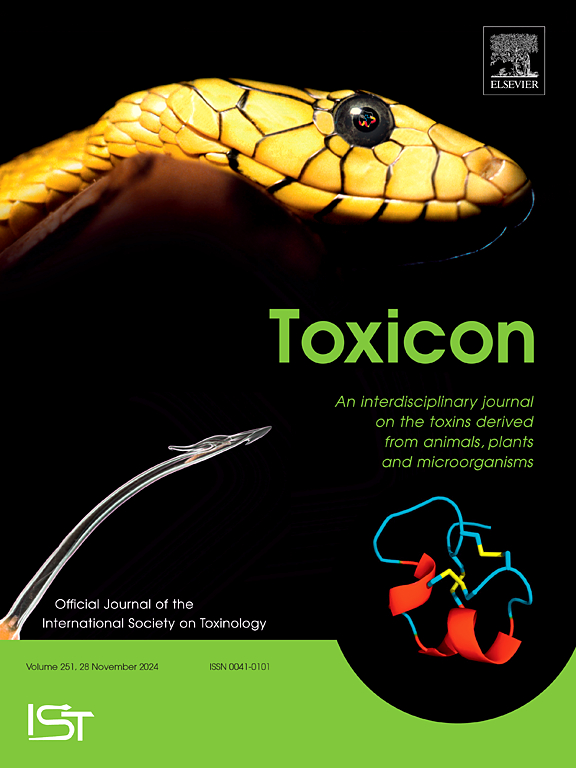Toxicity of the marine glycosidic macrolides, polycavernoside E and akunolides, from Okinawan cyanobacterium Okeania sp. in mice
IF 2.6
4区 医学
Q2 PHARMACOLOGY & PHARMACY
引用次数: 0
Abstract
The toxicity of polycavernoside E and its structurally related macrolides, akunolides A, B, and C, was evaluated in mice. These compounds were recently isolated from the marine cyanobacterium Okeania sp. collected in Okinawa, Japan. The minimal toxicity of polycavernoside E was estimated as 0.81 mg/kg by intraperitoneal injection, whereas those of akunolides A–C were >13 mg/kg. Owing to the considerable toxicity of polycavernoside E, the occurrence of this cyanobacterium should be considered in seaweed production environments.

冲绳蓝藻 Okeania sp.中的海洋糖苷大环内酯--聚醋酸苷 E 和阿库诺尔内酯对小鼠的毒性。
研究人员在小鼠体内评估了多杀菌素 E 及其结构相关的大环内酯类化合物--阿库诺尔内酯 A、B 和 C 的毒性。这些化合物是最近从日本冲绳采集的海洋蓝藻 Okeania sp.中分离出来的。经腹腔注射,聚葡萄球菌苷 E 的最小毒性估计为 0.81 毫克/千克,而akunolides A-C 的毒性则大于 13 毫克/千克。由于多刺五加皂苷 E 的毒性相当大,因此应考虑在海藻生产环境中出现这种蓝藻。
本文章由计算机程序翻译,如有差异,请以英文原文为准。
求助全文
约1分钟内获得全文
求助全文
来源期刊

Toxicon
医学-毒理学
CiteScore
4.80
自引率
10.70%
发文量
358
审稿时长
68 days
期刊介绍:
Toxicon has an open access mirror Toxicon: X, sharing the same aims and scope, editorial team, submission system and rigorous peer review. An introductory offer Toxicon: X - full waiver of the Open Access fee.
Toxicon''s "aims and scope" are to publish:
-articles containing the results of original research on problems related to toxins derived from animals, plants and microorganisms
-papers on novel findings related to the chemical, pharmacological, toxicological, and immunological properties of natural toxins
-molecular biological studies of toxins and other genes from poisonous and venomous organisms that advance understanding of the role or function of toxins
-clinical observations on poisoning and envenoming where a new therapeutic principle has been proposed or a decidedly superior clinical result has been obtained.
-material on the use of toxins as tools in studying biological processes and material on subjects related to venom and antivenom problems.
-articles on the translational application of toxins, for example as drugs and insecticides
-epidemiological studies on envenoming or poisoning, so long as they highlight a previously unrecognised medical problem or provide insight into the prevention or medical treatment of envenoming or poisoning. Retrospective surveys of hospital records, especially those lacking species identification, will not be considered for publication. Properly designed prospective community-based surveys are strongly encouraged.
-articles describing well-known activities of venoms, such as antibacterial, anticancer, and analgesic activities of arachnid venoms, without any attempt to define the mechanism of action or purify the active component, will not be considered for publication in Toxicon.
-review articles on problems related to toxinology.
To encourage the exchange of ideas, sections of the journal may be devoted to Short Communications, Letters to the Editor and activities of the affiliated societies.
 求助内容:
求助内容: 应助结果提醒方式:
应助结果提醒方式:


